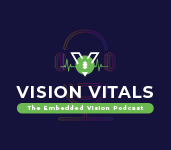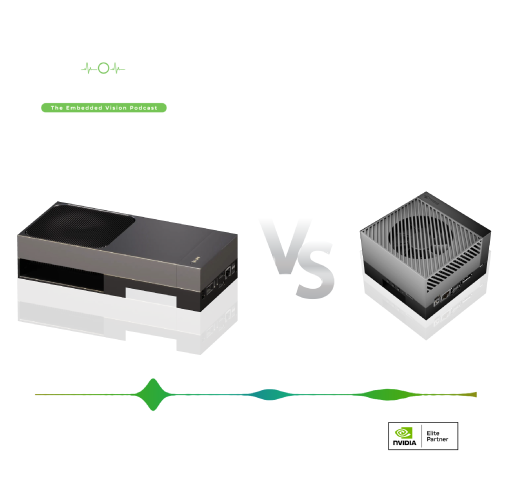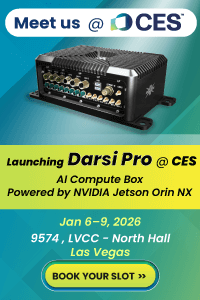Welcome back to Vision Vitals - e-con Systems Podcast.
Last week, we kicked off with an overview of NVIDIA's Jetson AGX Thor—what it is and why it matters.
Today we're zooming in. How does Jetson Thor actually differ from the Jetson Orin modules many run today?
Hi. Happy to be here.
Let's set the stage. Where does Jetson AGX Thor sit relative to Jetson AGX Orin?
Speaker:
Jetson AGX Thor is the new top end of the NVIDIA Jetson family, aimed at robots and machines that need heavier AI workloads than Jetson AGX Orin can comfortably handle. Think multi-model pipelines, richer perception, and onboard reasoning at higher speeds.
Industry analysts frame Thor as bringing 'data-center-class' AI to autonomous machines, which is a useful mental model when you're planning the next generation of platforms.
Host:
Let's talk numbers. What's the headline performance leap?
Speaker:
Two big ideas. First, throughput: Jetson Thor is quoted in FP4 TFLOPS, while Jetson Orin is typically referenced in TOPS. That shift reflects newer transformer-style workloads and low-precision inference that modern robotics stacks rely on.
Second, the scale: independent write-ups and community coverage highlight Jetson Thor's massive teraflops FP4 capability and the corresponding jump over Jetson Orin's class, which tops out around 275 TOPS. For context, Jetson Thor delivers up to 2070 TFLOPs FP4 compared to AGX Orin's 275 TOPS, Orin NX at 100 TOPS, and Orin Nano at 40 TOPS.
Jetson Thor also carries 2560 CUDA cores with 96 Tensor Cores, while AGX Orin runs up to 2048 with 64, Orin NX at 1024 with 32, and Orin Nano ranges from 512 to 1024 with 16.
Practically, it means running bigger multi-sensor models simultaneously with headroom for planning and language-in-the-loop tasks that would saturate an Orin.
Host:
What about memory ceilings and system plumbing?
Speaker:
Thor raises the bar on memory capacity and bandwidth, which matters when you're stitching together multi-camera vision with depth, radar, or LiDAR while keeping maps and policies resident. That's 128 GB LPDDR5X at 273 GB/s, compared to AGX Orin's 32-64 GB at 204.8 GB/s, Orin NX's 8/16 GB at ~102 GB/s, and Orin Nano's 4/8 GB at ~68 GB/s.
The platform also targets the kind of high-speed I/O and sensor density that advanced robots need. For camera developers, that translates into larger, richer vision graphs running locally, and a cleaner path to true sensor fusion at the edge.
Host:
It is known that power envelopes decide what you can ship. So, how do Thor and Orin compare here?
Speaker:
Thor is designed with a flexible power range to scale from compact mobile robots to larger, thermally richer systems. That versatility makes it easy standardize on one compute path and tune for form factor, instead of maintaining separate designs for small and large platforms.
It's a step up from many Orin deployments where you're watching every watt at higher utilization.
Host:
Could you share some examples? For instance, what becomes practical on Thor that's tough on Orin?
Speaker:
Well, there are a few clear patterns.
1. For instance, multi-camera 3D perception with learned depth, dense optical flow, and segmentation running concurrently.
2. Policy + perception stacks where you pair a vision backbone with trajectory prediction and a language or planning model for task reasoning.
3. Higher-fidelity inspection or manipulation tasks that need bigger context windows and faster re-planning.
These are the 'physical AI' use cases media coverage keeps calling out—the idea that robots are reasoning and acting in the world with data-center-like AI available onboard.
Host:
Now, word is going around that many have mature AGX Orin stacks. How should they think about timing?
Speaker:
Two angles. Firstly, Jetson AGX Orin remains a great fit for cost-sensitive projects and stable workloads. It has a broad ecosystem and proven paths to production. Secondly, if your roadmap includes denser sensing, foundation-model-style perception, or policy learning on-device, Jetson AGX Thor gives you the headroom to ship those features on a single module instead of juggling accelerators.
Analysts also point out the reality: next-gen capability comes with next-gen pricing, so it's important to sequence pilots where Jetson Thor's capability delta lands real product wins.
Host:
Quick word for embedded vision developers listening in. What's the practical takeaway?
Speaker:
If you're building multi-camera robots or machines, Jetson AGX Thor widens your model size, concurrency, and fusion options. It's great news for advanced HDR, global shutter arrays, or mixed-modality rigs.
For folks already shipping on Jetson AGX Orin, your migration thinking should map which parts of the pipeline are compute-starved today and prototype those first on Thor. It's a good baseline when you evaluate where Thor meaningfully changes your BOM or your software architecture.
Host:
One last question. For those looking at Jetson AGX Thor, how should they think about evaluating vendors and partners for their projects?
Speaker:
I'd suggest looking at three things.
First, check whether the vendor has a track record across multiple Jetson generations. That shows they understand NVIDIA's evolving products.
Then, look for proven multi-camera and sensor integration experience, since Thor is really built for dense, fused workloads.
Finally, make sure they can offer both off-the-shelf hardware and customization support when needed.
That's where e-con Systems stands out. We've been delivering camera solutions on Jetson platforms for years, from Orin back to Xavier, and we have already aligned our camera portfolio for Thor.
So, you'll get camera solutions that integrate seamlessly, which means that developers receive the performance headroom needed for next-gen AI robotics from day one.
Host:
Thanks for the clear breakdown. This has been extremely insightful.
Speaker:
Thanks for having me. I very much enjoyed sharing my insights on this remarkable new platform.
Host:
So, folks, that's it for this episode of Vision Vitals.
In case you missed our first episode that introduced Jetson AGX Thor, you can check it out by browsing our playlist.
For more details on our embedded vision expertise, please visit www.e-consystems.com.
We'll be back next week with more practical insights. And we hope you'll be here!
Take care and have a great week.
Close Full Transcript




 Mr. Thomas Yoon
Mr. Thomas Yoon +82-10-5380-0313
+82-10-5380-0313










